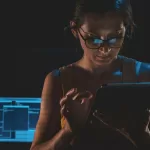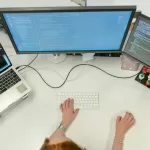Virtual classrooms let teachers and students interact and learn together even when they are not in the same place. These days, education is evolving quickly, hence digital learning environments are sometimes used either alongside or rather than traditional classrooms. By letting teachers and students interact and participate in a globally minded setting, these virtual classrooms destroy the walls preventing people from learning outside of the classroom. This is changing our opinions about education and teaching. Children all around gain from this.
Virtual Classrooms Provide What Function?
Teachers and students can engage live online in virtual classrooms, same as in a traditional classroom. Live chats, videoconferencing, and digital whiteboards let people in these digital surroundings learn and interact with each other. Since they are somewhat adaptable, real classrooms let people from all around the world cooperate and meet.
Virtual classrooms differ from online courses or lectures ahead of time since they focus live, interactive learning and so when students raise their hands, ask questions, and participate in group projects, the classroom comes alive and vibrantly. Using this method, teachers might assess students in real time and give comments and instruction. This results in more customized learning‘s process.
How Online Courses Are Linking Schools All Around the World
Students and teachers working from a virtual school can do so from anywhere. Virtual classrooms offer opportunities not found in places where a good education could be difficult. Students today can learn under experienced teachers even if they reside far away or somewhere lacking enough assistance. More fair schools result from the sharing of resources and information among people from all around the world.
Virtual classrooms also facilitate the simple sharing of ideas, cultures, and points of view among people from all walks of life. From diverse backgrounds, students may hang out, work on projects, and exchange personal tales. This makes the education more interesting, educates students more about the world, and gets them ready for a worldwide employment market. The knowledge acquired in this job assists teachers to improve their lessons.
How Then Virtual Classrooms Use Technology?
Making virtual classrooms successful is mostly dependent on using current technologies. Among the most important parts of these online classrooms are live lectures, videoconferencing, and interactive technologies. We now need online meeting applications as Google Meet, Microsoft Teams, and Zoom if we are to connect in real time.
They also make it easy for educators to track student development, manage their tasks, and give them information. Among the various are Canvas, Blackboard, and Moodle. Students can access resources, interact in forums, and collaborate on projects right here on these sites. They also offer online courses.
Another thing you should consider is that interactive technologies such as digital whiteboards and screen sharing give online courses the sense of real ones. Using these technologies helps teachers to engage with students instantly and clearly communicate ideas, so making learning more fun. As participants get more active, including quizzes, polls, and conference rooms, virtual learning gets much more fun.
Virtual Classrooms Offer Various Advantages
The great advantage of online learning is a great degree of freedom. Students can utilize the internet to engage in class anywhere—including their own homes. Those who work, have children, or are students whose schedules would conflict would cherish this freedom most. Virtual classrooms let students finish projects and other responsibilities without sacrificing their degree of education.
Another benefit of virtual classrooms is its flexibility in terms of instruction. Real-time comments let teachers change their lessons or provide every pupil new tools to fit their needs. Working with children who learn in various speeds and in varied methods will assist to ensure that none falls behind.
Online courses also help to control expenses. In traditional education, for instance, the costs of materials, transportation, and classroom space make things fairly costly. Virtual education helps to lower these costs. Children from all around the world can so attend school for less money and under fewer difficulties.
Virtual Classrooms Have Certain Difficulties
The digital divide is one of the main problems with virtual classrooms, which also have certain benefits. Some students thus cannot participate in virtual learning since they lack broadband internet or the required gadgets. This difference can prohibit certain children from getting the same education, thereby disadvantaging them.
Also negative is people’s incapacity to interact with one another. Students enrolled in virtual classes can interact in real time, even though they cannot exactly copy the social elements of studying in person. Teenagers and young adults who personally connect with their teachers and peers could miss forming friendships and feeling like they belong.
Online classes are also challenging to keep students engaged in. When their teacher is not around, some students could find it difficult to stay on goal or motivated. Teachers must devise fresh ideas to keep their pupils interested. They should, for example, make lessons interesting, follow up with students regularly, and employ multimedia to liven up learning.
Online Learning Future Developments
Virtual classes made possible by technology enable much more. Future enhancements could be avatar (AR), virtual reality (VR), and other immersive technologies. This could make learning venues even more exciting and fun. Students could virtually travel fields of interest from home to science labs, museums, historical sites, or other cultural symbols.
Artificial intelligence (AI) could also revolutionize online learning by means of artificial intelligence technologies, which would give teachers real-time data to enable them to monitor student progress, handle labor-intensive office activities, and give tailored one-on-one education. Statistics show that this strategy helps teachers to spot difficult students and help those most in need.
Given that more and more people work from home, virtual education will also stay rather important for kids becoming ready for the digital economy. Right now, there are lots of jobs calling for someone with knowledge of technology, time management, and self-discipline. Virtual learning lets students gain up these skills.
Finally…
Virtual classes combining teachers and students from all around the world are changing the learning process. These digital classrooms use technology to make learning unique for every student flexible and simple accessible. They can thus meet the demands of multiple students. Virtual classrooms clearly could change our future learning environment, even if issues including the digital divide and students’ lack of enthusiasm in learning still exist. Virtual classrooms will always bring new tools and ideas to apply. They link all individuals since they make learning more reachable for everyone and top priority in global education.









